The United States have participated in the Olympics in ice hockey 21 times since 1920, with their best results being a pair of gold medals in 1960 and 1980, both times as hosts of the Olympics. Most recently, they were silver medalists in Vancouver and have historically done well during Olympics held in North America, having medaled four of the last five times the Games were held in the US or Canada dating back to 1960. Other medals won by the United States are silver medals in 1920, 1924, 1932, 1952, 1956, 1972 and 2002 as well as their only bronze, which came in 1936.
The 1960 USA gold medal team celebrates
The United States are regular participants in the World Championships, having first participated in 1931, where they won a silver medal, the first of four silvers they would win up through 1950. Their highest finish at the World Championships came in 1933 when they won the gold medal. The 1960 Olympics also counted as the World Championship back then, giving the USA a total of two golds. The American's bronze medals came in 1949, 1962, 1996 and 2004.
Considered one of the hockey world's top six teams, the United States have also participated in the six team Canada Cup five times, with a best finish of second in 1991, and the eight team World Cup of Hockey twice, winning the championship in 1996.
The 1996 United States National Team poses with the World Cup
The United States enters the 2014 Olympics with all 25 players on it's roster from the NHL. It has also completed it's youth movement, which began after the 2004 World Cup with all of it's players now born after the last gold medal was won in 1980 and three born in the 1990's. In comparison, in 2006 16 of the US squad were born in the 1970's with two more born in the 1960's!
Both Jonathan Quick and Ryan Miller (the oldest member of the team at 33) return in goal for the Americans, as well as nine of their 14 forwards, but the defensive corps has had an almost complete turnover, with just Brooks Orpik and Ryan Suter back from 2010.
Up front, newcomers T. J. Oshie, Max Pacioretty, Derek Stepan, James van Riemsdyk and Blake Wheeler join returnees David Backes, Dustin Brown, Ryan Callahan, Patrick Kane, Ryan Kesler, Phil Kessel, captain Zach Parise, Joe Pavelski and Paul Stastny.
While the US went into the 2010 Olympics without a single forward who had ever scored a goal in the Olympics, four years later they enter the Games with a healthy dose of experience and leadership on offense.
Zach Parise (9) and Ryan Suter (20) will lead the Americans in Sochi
With the format for this year's Olympics calling for the top four teams after the Preliminary Round to receive byes into the quarterfinals, the key for the United States will be defeating Slovakia in regulation time in their opening game on February 13th and taking points out of their game against Russia two days later, as each of the other three clubs should be able to take the full three points from Slovenia with ease. With four byes into the Quarterfinals up for grabs, securing one of those should be within reach for the Americans as long as they take care of business against Slovakia to open the tournament.
The United States, like so many other teams, will go as far as their goaltending can carry them. Quick is having a good season in Los Angeles and can be a difference maker, while Miller has the experience of leading the US to the gold medal game in Vancouver. The defense is anchored by Suter, who will likely enjoy seeing less ice time in Sochi than he is required to play by the Minnesota Wild.
Kane and Kessel lead Americans in NHL scoring and they must find the net in order for the Americans to advance through the playoff round and contend for a medal, but are far from the only ones who can be counted on, with Pavelski, Wheeler, van Riemsdyk and Oshie all with 40 points or more.
Today's featured jersey is a 1996 United States National Team Pat Lafontaine jersey as worn during the 1996 World Cup of Hockey. While this jersey had a short life span of just two years, it was worn during one of the United States finest moments, victory over Canada at the inaugural World Cup of Hockey. With it's very short life span, unusual styling and championship pedigree, it's one of the most sought after jerseys by collectors.
The white ones were sold at retail, both with and without names, but the blue ones were apparently created only for the team itself, making them a Holy Grail for many. The white ones were sold customized as #2 Brian Leetch, #35 Mike Richter and #27 Jeremy Roenick, yet Roenick never played in the World Cup! This was due to him not having an NHL contract at the time, and therefore no insurance coverage should he suffer a major injury, which forced him to sit out the tournament, making jerseys customized with his name and #27 "close but not quite" in terms of accuracy.
Also of note, none of the white ones sold at retail had the 1996 World Cup of Hockey 3" diameter logo patch on the upper left arm and the Leetch jerseys did not come with the captain's "C". While any decent customizer can add a proper "C" to a jersey still needing one, the supply of the now 18 year old tournament logo patches dried up several years ago and are now virtually impossible to find anymore, only adding to the desirability of a properly patched and fully customized example.
This particular jersey started out as a retail blank version, which meant it came with only a sublimated USA crest, as opposed to the embroidered crest patches which adorned the customized examples, which were number sized (48, 52, etc.). Obtaining a blank version, which were letter sized (L, XL, etc.), did give us the choice of which player to add to the back of our jersey. We then purchased an embroidered crest to add to ours to raise it up to the level of the customized retail versions and then added the World Cup logo patch for even more added authenticity.
Lafontaine played for the United States on six occasions, the first being in the 1984 Olympics. He also appeared in the 1988 and 1992 Canada Cup tournaments, the 1989 World Championships, the 1996 World Cup of Hockey and concluded his international career with the 1998 Olympics, the first one which featured the pros of the NHL.
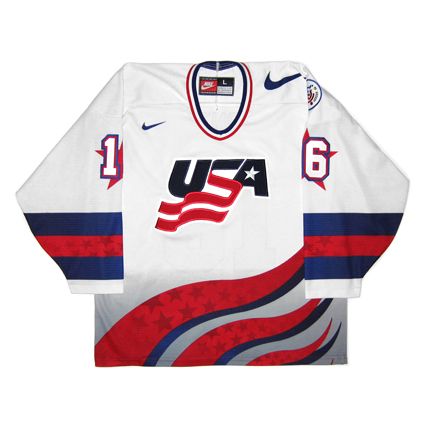
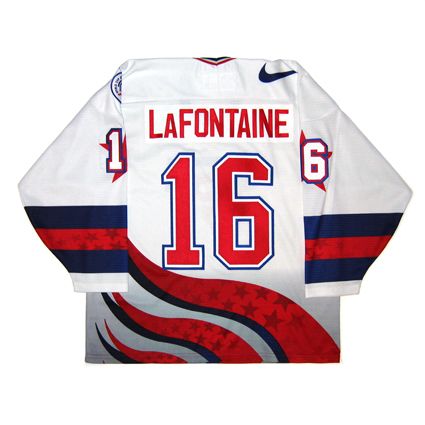
Here is a look at the jerseys that the United States will be wearing in the 2014 Olympics in Sochi. While some teams in Sochi are being outfitted with some pretty wild and experimental designs, the United States has been given an overall very sharp pair of jerseys for 2014. The shield design is loosely based on their 1932 jerseys, which were worn as throwback styles at the 2004 World Cup of Hockey and again at the 2005 World Juniors.
We're not exactly thrilled with the use of the nearly invisible stars on the shoulders, wishing they would have been either white, or not there at all. From a collector standpoint, we wonder how this heat sealed treatment of subtle designs will wear over time, as many of our early CCM jerseys with heat sealed designs, such as stars on the shoulders and chest of NHL All-Star Game jerseys have begun to loosen and peel off over time.
We're even less excited about the appliqué faux laces, as simply using real ones would look a hundred times nicer and a lot less "cheap". We're also surprised to see Nike sticking with the same font for the names and numbers as used for quite some time now, as this is a decidedly retro looking style paired with modern looking lettering.

First up today are highlights from the 1996 World Cup of Hockey, won by the United States, their last major international championship at the senior level.
Here is Billy Christian's game winning goal versus the Soviet Union in the 1960 Olympics on the next to last day of the tournament, a game played outdoors.
Finally, the trailer from the movie "Forgotten Miracle" about the gold medal winning 1960 USA Olympic Hockey Team.

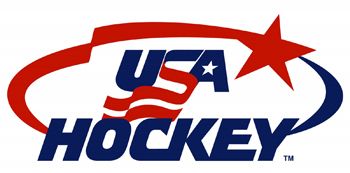
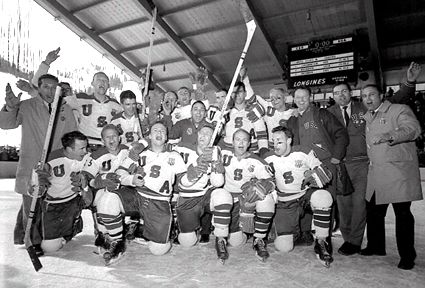
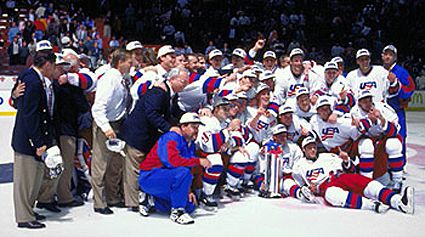
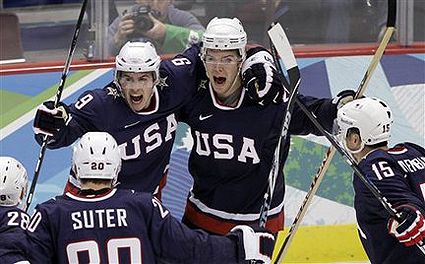
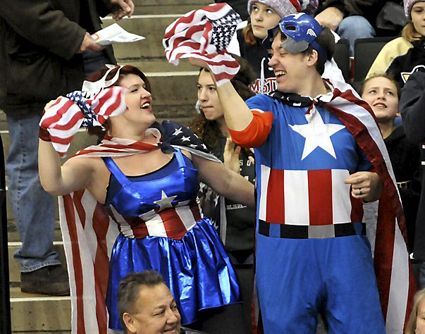













No comments:
Post a Comment
We welcome and encourage genuine comments and corrections from our readers. Please no spam. It will not be approved and never seen.